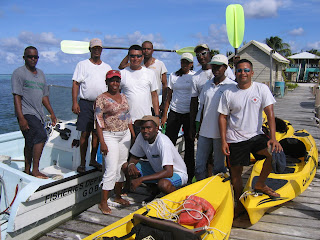
Charles Acosta held another Long Term Atoll Monitoring Program (LAMP) survey training this August, the 4th one since LAMP surveys were established at Glovers Reef.
The LAMP protocol is designed specifically for the long-term monitoring of physical and biological parameters at Glover’s Reef atoll and for generating data comparable to the existing CARICOMP (Caribbean Coastal Marine Productivity protocol was created to monitor the Caribbean basin).
LAMP is divided in different sections, one of which is the Fisheries monitoring. This focus on the commercial species of Glover’s Reef, including Spiny lobsters (Panulirus argus; P. guttatus), queen conch (Strombus gigas), mutton snapper (Lutjanus analis), hogfish (Lachnolainus maximus), queen triggerfish (Balistes vetula), Nassau grouper (Epinephelus striatus) and black grouper (Myteroperca bonaci).
Monitoring the variation in abundance of these target species gives information to managers to evaluate the effectiveness of the no-take zone and be able to adjust the regulations accordingly. For species with open and closed seasons (in addition to no-take zones), like lobsters and conchs, measurements are taken before and after open season. This gives an idea of the impact of fishing on the population of these species and helps answer questions such as should there be quotas on the number of fish to catch? Is there overfishing? Are the population healthy and capable of maintaining themselves? It also helps measure the level of poaching in the no-take zone where no fishing is allowed.
The LAMP training gives the opportunity for reserve biologists to go over the simple field methods and ask questions and to make sure everyone is measuring the same thing. It also gives the aprticipants an extra boost of motivation to go out there and spend hours underwater counting conchs!
Some information about Closed Season:
Open and closed fishing season are usually established for animals that reproduce and hatch their eggs at a known period. For example a female lobster caught during closed season will usually have eggs under her abdomen.
Unfortunately due to various reasons high value species such as lobster, conchs and groupers are still fished during closed season.
As a consumer there are simple steps you can take to help stop the poaching.
-When you are traveling be aware that most countries will have closed seasons for species like lobsters. So remember to ask.
-For all ceviche and lobster lovers: Belize OPEN season (so go ahead and enjoy them)
For lobster: July 1st to September 30th
For conch: Oct 1st to June 30th
-Do not order or buy conchs and lobsters outside of the open season. In Belize although fishing becomes illegal, restaurants are still allowed to serve these products. In the case of lobsters the restaurants buy the ones “prepared” for export. These lobsters will most likely be caught during their reproduction/spawning critical period.

LAMP participants leaving in Physalia, one of Fisheries boat.









